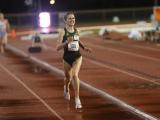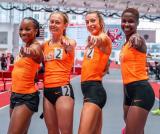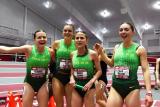Folders |
Bill Dellinger at 90: Reflections From The 'Other Guys'Published by
Legendary Oregon Distance Coach's Influence Spanned Decades And Still Going By Philip Levinson for DyeStat Photo (above) courtesy of the Eugene Register-Guard “I couldn't do that. Could you do that? Why can they do it? Who are those guys?” – Butch Cassidy, Butch Cassidy and the Sundance Kid March 23rd has arrived and it's a milestone. It’s the day we wish a Happy 90th Birthday to Bill Dellinger, the most legendary track and distance running coach around. We all know about Dellinger’s exploits, first as an athlete: two-time NCAA winner and three-time All-American for Oregon, running as Bill Bowerman’s first exceptional distance runner. He also set two world indoor records, six American records, and competed in the three Olympics – 1956, 1960 and 1964, winning a 5,000-meter bronze medal in Tokyo. We also know about Dellinger’s headlines as a coach: 29 years as head cross country coach and 25 years as head track coach for Oregon, capturing five NCAA team championships with numerous runner-up finishes, as well as coaching many athletes to individual NCAA titles. And we know about the noted runners who ran for him at Oregon and beyond – including Prefontaine, Centrowitz, Salazar, Chapa, Cruz and McChesney, all of whom won individual NCAA titles, broke American records, or became Olympians. Behind these headlines, however, many may not fully appreciate how many unheralded runners ran for Dellinger and also flourished. It’s this other group – Bill’s Other Guys – who helped form the backbone of his best Oregon teams and include many who also reached great heights. It’s this less-celebrated set of runners whom I think of on Dellinger’s birthday for a variety of reasons. Providing a long leash — letting you be you. Former Bowerman and Dellinger runner, and now a coaching legend himself, Pat Tyson talks about Dellinger’s approach with walk-ons. “Well, if you totally believed in the system, trusted the coach, and weren’t afraid of hard work, he might like you,” Tyson said. “In 1971, it was me, Mike Long and Mark Savage, all three walk-ons, and we were 50 percent of the team that won the NCAA Championships.” That 1971 Oregon men’s cross-country team with Tyson, Long and Savage – and led by Pre – won NCAAs and served as Dellinger’s first of four eventual XC team titles. What were the keys to Dellinger’s success with those and subsequent runners? “Bill gave us a long leash,” Tyson said. “He did not over-coach us. You had to be a self-starter. He's got the workouts, but he's not gonna baby you. He made things very simple. He worked us hard, and we weren't afraid of it.” Tyson reflected a moment and added: “Dellinger also let you be you. His approach was to let Prefontaine be himself, let Mark be himself, and let me be me. It's not, ‘Let's analyze everything every second.’” “Six minutes with him was like an audience with the pope” Coaching but not over-analyzing are Dellinger trademarks. Art Boileau, who walked on at Oregon after Bill discovered him in a college PE class, elaborated on Bill’s long-leash approach. “As a coach, Bill had an Oregon sensibility because he's a man of few words,” Boileau said. “I used to go by his office and go in there, knowing I can take about six minutes of his time, just to let him know what I'm planning to do and get his views. Six minutes with him was like getting an audience with the pope.” Yes, six minutes with Dellinger felt about right for the man who chose his words – and wanted you to choose your words – wisely. The result: a coach and group of athletes that inspired each other, not as much by words but by actions and consistency. From PE class to Olympian Boileau pointed to the smart, steady influence of Dellinger and his ongoing training with other elite Oregon runners as keys to him evolving into a member of Oregon’s 1977 NCAA Championship-winning XC team and then into an eventual Olympian, Boston Marathon runner-up, and two-time L.A. Marathon winner with a 2:11:15 marathon PR. Alluding to Dellinger’s stint in the Air Force, Boileau said, “I love Bill because, with his military background, he was not one of these touchy-feely guys. I was fine with that. Bill respected people if you're out there and you're training seriously — then there's room for you.” Yes, Dellinger made room for those who trained seriously and consistently. His Oregon distance running workout squads sometimes exceeded 35 athletes, with perhaps a half-dozen world-class runners or alums and more than 20 walk-ons. One source for these Other Guys: Dellinger’s one-week summer track camps, which I participated in four times, with as many as 250+ athletes per session. “Hey, Fella, would you like to run at Oregon?” Boileau laughed as he discussed the unique nickname Dellinger used with him and each of these Other Guy athletes: “He would call us ‘Fella.’ One runner once said to me, ‘He always calls me ‘Fella.’ I don't think he knows my name.’ I said, ‘I guarantee he doesn't know your name. But run 13:30 (for 5000m), then he'll know your name.’” Another Other Guy runner, Dan Nelson, connected with Bill and decided to walk-on at Oregon. “I grew up in Baker City, and I wasn't highly recruited,” Nelson said. “I met the McChesneys who said they would talk to Bill about me. I can still remember the day when my mom picked up the phone. She said, ‘Bill Dellinger is on the line for you.’ He then said to me, ‘Hey, Fella, would you like to run at Oregon?’ I said, ‘Sure.’” As with many Oregon walk-ons, Nelson struggled at first amidst a swarm of other runners but then adjusted. “I had some struggles for the first couple of years," he said. "If I was a walk-on at any other school, they probably just would have said goodbye. That never happened there. Bill having that even-keel mindset was helpful because it allowed me time to get things going in the right direction.” Nelson would soon improve considerably, eventually going on to make the 1991 and 1993 World Championship teams in the steeplechase and 10,000 meters, respectively. As with Tyson and Boileau, he pointed to the consistency of Dellinger’s approach as key. “He just said, ‘Get out there, practice, get the work done, be consistent.’ I finally figured it out, and that's when I started improving a lot.” A humorous side A hallmark of Dellinger’s style was his wry sense of humor. Nelson remembered seeing him just after winning the NCAA steeplechase in Baton Rouge in spring 1987: “I had to go to drug testing afterwards. I looked for Bill in the stands. He looks at me, smiles and says, ‘Hey, Fella, you ran a great race. You made the trip worth it.’” Dellinger liked using humor to emphasize key points with his runners. One of his post-collegiate world-class runners was Ron Tabb, who did not even start running until late in high school but found success after college as a marathoner. In early 1983, he turned to Bill for help as he worked to re-energize his running career. “Just before the Boston Marathon in 1983, Bill and I discussed how he wanted me to run,” Tabb said. “He knew my reputation for going out hard. He told me to run conservatively. He said if he saw me leading early, he would take a baseball bat to my knees when I got back to Eugene.” The result? Tabb ran conservatively and finished second in 2:09:31, becoming the fifth-fastest American marathoner ever at that time. When that humorous and fun side of Dellinger showed, it proved infectious. One need only see pictures of him celebrating Oregon’s 1984 NCAA team track championship with his athletes – a team that represented a perfect blend of heralded and unheralded competitors that won the title at Hayward Field as underdogs. Another example is the story Matt Centrowitz shared in the Dellinger documentary The Magician of being outplayed and hustled by him at the pool table as a freshman in front of 40 of his friends and teammates. Three themes to Other Guys’ success Dellinger will always be remembered for preaching intelligence and tenacity. He coached eventual steeplechase Olympian Danny Lopez, who transferred to Oregon from Central Arizona Community College in 1989. “I didn’t come in as a superstar by any means,” said Lopez, whose challenges were exacerbated by being legally blind in one eye. “Coming into the steeple, I had a lot to learn. It didn’t help having vision in only one eye, as I don’t see the barriers the same way others do. But to Bill, that was just an excuse that I had to get over.” These three themes of unwavering fearlessness, consistency and determination may seem to be clichéd in the sport of distance running, in which everyone echoes these sentiments. But these ring completely true as characteristics of Dellinger’s coaching and the qualities he instilled in his successful runners. From Bowerman to Dellinger – intelligent runner to intelligent coach One need only watch the last two laps of Dellinger’s bronze-medal winning 5,000-meter race in the 1964 Olympics to see dramatic examples of these strengths: from boldly taking the lead with 600 meters left, to steadily fighting back with 150 left from fifth place to snatch third place at the line. Understanding how intelligently Dellinger ran himself, and how intelligently he was coached by Bowerman, makes it no mystery as to why he also coached so intelligently. At his Oregon retirement ceremony at Hayward Field in 1998, Dellinger credited Bowerman with his own success as a coach. “I think I was one of the lucky ones,” Dellinger said. “I got to run for Bill Bowerman, and then I got to have him as my mentor.” The result of that mentorship: Dellinger’s intelligent running and intelligent coaching. “Bill made us work hard but also smart,” Lopez said. “He created a positive attitude, a hard work ethic, and a belief in what was possible.” In addition to Lopez, Tabb, Nelson, Boileau, Tyson, there are so many more of Dellinger’s Other Guys – unheralded runners – who blossomed under his coaching and teaching. With the running intelligence that Dellinger fostered in his athletes, it is not surprising that so many of them carried on the Bowerman-to-Dellinger legacy and became successful coaches themselves, including Tyson, the head cross country and track coach at Gonzaga. “Best decision I ever made was to run for Bill at Oregon” I can vouch for the strengths of Dellinger as a coach for these Other Guys as one of his walk-on runners myself – even though I was also one of his slowest. After participating in four of Dellinger’s summer track camps, and despite showing little potential, I wrote to him during my high school senior year. I inquired about whether I might be welcome to join as a walk-on at Oregon. Dellinger, who once sent a 2-sentence recruiting letter to high school senior Steve Prefontaine, responded to me as a high school senior with a 7-sentence letter, which included this excerpt: “Dear Philip: You went through some trouble explaining who you are when it really wasn’t necessary as I remember you from our track camp. I say that in a positive way as you were a good man at our track camp and I’m sure with your sincere interest in running, you will continue to improve to become a very fine runner….If you are interested in the University of Oregon as a walk-on, we would be more than happy to have you.” I was easily one of Dellinger’s least promising athletes. But he and his program accommodated runners ranging from world-class post-collegians to NCAA champions to all the way down to my level. As I trained, he selectively shared encouraging or pointed words with me as my own running at Oregon progressed or stalled, just as he did with others. In other words, we all got our occasional, albeit infrequent, six-minute meetings with Dellinger. “The best decision I ever made was to come to Oregon and run for Bill,” said Mike Blackmore, who evolved into a track All-American in the 5,000, a sub-four miler and a member of the 1984 NCAA title-winning track team. “I was injured my first couple years at Oregon. But Bill was very patient with me.” Blackmore is now the coach at NCAA Division III Linfield College. Patience as a unique strength Indeed, patience may be one of the great strengths of Dellinger’s coaching and teaching: patience not just as he gathered his athletes in the old West Grandstands at the old Hayward Field to time them during some of his most punishing workouts, such as the famous 30th Avenue Drill; patience not just as his runners adapted and progressed, two of the five training principles Dellinger preached as part of the Oregon system; but also patience as he watched many of his walk-on runners steadily improve over months and years. This quality may even distinguish Dellinger from his own coach Bowerman, with whom he shared such a long and storied relationship. There is clearly a place for both illustrious men in a mythical all-time coaches’ Hall of Fame, even though Bowerman’s legacy – with his bold, pioneering history and his unique role as Nike co-founder – often overshadows Dellinger. But therein may lie a clue as to why Dellinger was so patient in opening up his program to so many Other Guy runners. Perhaps he inherently viewed himself, the former Springfield High runner and onetime Thurston High and LCC coach, as one of these Other Guys as well. Dellinger’s longtime assistant track coach, John Gillespie, captured this theme in discussing Bill’s coaching start at Oregon: “People don’t realize that although he’s a distance coach, he started out at Oregon being the field events coach because Bowerman was there. Bowerman hired Bill as his assistant because he needed someone to coach (field events).” Indeed, adaptability and patience are recurring themes of Dellinger’s life, especially in recent years as he resolutely battles health problems. He suffered a debilitating stroke in 2000, which threatened his life and hindered his ability to speak. His son, Joe, attributed his ability to not just survive but stay semi-active for over two decades to a characteristic trait: “His competitiveness,” Joe said. “His stroke brought that out. To function the way he’s functioned since – with no cane – it’s his drive.” Bill opens his home to his runners – yet again Indeed, Dellinger’s drive and patience are evident as he pushes forward despite these health setbacks. He has continued to make appearances, including at events at the new Hayward Field and the September cross country meet that now bears his name – the Bill Dellinger Invitational. Tyson is not at all surprised at Dellinger’s persistence. “As a coach, Bill always had the ability to be patient,” he said. “Bill is blue collar. He always knew that it's the long haul, not the short haul. And he loves his people. To this day, Bill opens his house for any of his runners to come back and visit him.” Dellinger once discussed patience as a defining characteristic in running: “One of the ingredients to being a great distance runner is patience,” he said. “You grow into being a great distance runner, it doesn’t happen overnight like a miracle.” These same words could be said of Dellinger’s own coaching success — forged from patience across decades with hundreds of athletes. On March 23rd, Bill will open his house yet again to welcome many of these runners from these decades back to celebrate his milestone birthday. “Who are those guys?” you ask. We are Dellinger’s runners, a fearless and relentless group. We wish Bill a Happy 90th Birthday. And we give him all the heartfelt thanks he has earned. We’re just not quite sure we can do all that in six minutes. ---------- Philip Levinson, who ran at Oregon for Bill Dellinger as a walk-on for three years, has published articles in TechCrunch, Business Insider, InformationWeek, TheNextWeb and Huffington Post. His last running article was “Outrunning Forrest: On Running My 50,000th Mile.” More news |














